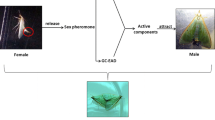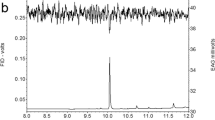Abstract
cis-7,8-Epoxy-2-methyleicosane is a sex pheromone component of the Casuarina moth, Lymantria xylina Swinhoe. The compound was extracted from pheromone glands of female moths and was identified by coupled gas chromatographic–electroantennographic detection (GC-EAD) and GC–mass spectrometry. In field experiments in Taiwan, traps baited with either or both of (7R,8S)-cis-7,8-epoxy-2-methyleicosane (>99% ee) [termed here (+)-xylinalure] and (7S,8R)-cis-7,8-epoxy-2-methyleicosane (>99% ee) [termed here (−)-xylinalure] captured male L. xylina. Addition of further candidate pheromone components to xylinalure did not enhance its attractiveness. Demonstration of whether or not female L. xylina produce both optical isomers of xylinalure, and determination of the ratio, will require pheromone extract analyses on a chiral, enantiomer-separating column (as yet unavailable) or derivatization of epoxides in accumulated gland extracts. Attraction of male L. xylina to either enantiomer of xylinalure contrasts with enantiospecific production of, and/or response to, epoxy pheromones in congeners. With no other nocturnal lymantriid moth known in Taiwan to utilize xylinalure for pheromonal communication, enantiospecific “fine tuning” of xylinalure, or evolution of a more complex pheromone blend, may not have been necessary for L. xylina to maintain specificity of sexual communication. Racemic xylinalure will be appropriate for pheromone-based detection surveys of L. xylina in North America.
Similar content being viewed by others

REFERENCES
Arn, H., StÄdler, E., and Rauscher, S. 1975. The electroantennographic detector—a selective and sensitive tool in the gas chromatographic analysis of insect pheromones. Z. Naturforsch. 30c:722-725.
Bierl, B. A., Beroza, M., and Collier, C. W. 1970. Potent sex attractant of the gypsy moth: Its isolation, identification and synthesis. Science 170:87-89.
Bierl, B. A., Beroza, M., Adler, V. E., Kasang, G., SchrÖter, H., and Schneider, D. 1975. The presence of disparlure, the sex pheromone of the gypsy moth, in the female nun moth. Z. Naturforsch. 30c:672-675.
CardÉ, R. T., Roelofs, W. L., and Doane, C. C. 1973. Natural inhibitor of the gypsy moth sex attractant. Nature 241:474-475.
CardÉ, R. T., Doane, C. C., Granett, J., Hill, A. S., Kochansk, Y. J., and Roelofs, W. L. 1977a. Attractancy of racemic disparlure and certain analogues to male gypsy moths and the effect of trap placement. Environ. Entomol. 6:765-767.
CardÉ, R. T., Doane, C. C., Baker, T. C., Iwaki, S., and Marumo, S. 1977b. Attractancy of optically active pheromone for male gypsy moth. Environ. Entomol. 6:768-772.
Chang, Y.-C., and Weng, Y.-C. 1985. Morphology, life habit, outbreak and control of casuarina tussock moth (Lymantria xylina Swinhoe). Q. J. Chin. For. 18:29-36.
Chao, J.-T., Schaefer, P. W., Fan, Y.-B., and Lu, S.-S. 1996. Host plants and infestation of casuarina moth, Lymantria xylina (Lepidoptera: Lymantriidae) in Taiwan. Taiwan J. For. Sci. 11:23-28.
Dool, H. Van den, and Kratz, P. D. 1963. A generalization of the retention index system including linear temperature programmed gas-liquid partition chromatography. J. Chromatogr. 2:463-471.
Grant, G. G., Langevin, D., L{ie2545-2}ska, J., Kapitola, P., and Chong, J. M. 1996. Olefin inhibitor of gypsy moth, Lymantria dispar, is a synergistic pheromone component of nun moth, L. monacha. Naturwissenschaften 83:328-330.
Gray, T. G., Slessor, K. N., Shepherd, R. F., Grant, G. G., and Manville, J. F. 1984. European pine shoot moth, Rhyacionia buoliana (Lepidoptera: Tortricidae): Identification of additional pheromone components resulting in an improved lure. Can. Entomol. 116:1525-1532.
Gries, G., Gries, R., Khaskin, G., Slessor, K. N., Grant, G. G., L{ie2545-4}ska, J., and Kapitola, P. 1996. Specificity of nun and gypsy moth sexual communication through multiple-component pheromone blends. Naturwissenschaften 83:382-385.
Hansen, K. 1984. Discrimination and production of disparlure enantiomers by the gypsy moth and the nun moth. Physiol. Entomol. 9:9-18.
Inoue, H. 1957. A revision of the Japanese Lymantriidae (II). Jpn. J. Med. Sci. Biol. 10:187-219.
Kishida, Y. 1995. Taxonomic notes on Lymantria xylina Swinhoe and L. sakaguchii Matsumura (Lymantriidae). Yugato 141:115-116.
Li, Y., Chen, S. L., Xie, Q. M., Cai, Q. J., Wu, J., Li, Y. M., Zheng, X. Q., Zhu, Z. W., Xhou, B. T., and Zheng, H. Q. 1981. Studies on the lymantriid moth, Lymantria xylina Swinhoe. Acta Entomol. Sin. 24:174-183 (in Chinese).
LÖfstedt, C., Metcalfe, P., Svensson, G., Kozlov, M., and Francke, W. 1998. Sex pheromones and speciation among pheromone morphs and cryptic species in the leaf-miner Erocrania semipurpurella. Second International Symposium on Insect Pheromones. WICC-International Agricultural Centre, Wageningen, The Netherlands.
Miller, J. R., Mori, K., and Roelofs, W. L. 1977. Gypsy moth field trapping and electroantennogram studies with pheromone enantiomers. J. Insect Physiol. 23:1447-1453.
Oliver, J. E., and Waters, R. M. 1995. Determining enantiomeric composition of disparlure. J. Chem. Ecol. 21:199-211.
Plimmer, J. R., Schwalbe, C. P., Paszek, E. C., Bierl, B. A., Webb, R. E., Marumo, S., and Iwakim, S. 1977. Contrasting effects of (+)-and (−)-enantiomers of disparlure for trapping native populations of the gypsy moth in Massachusetts. Environ. Entomol. 6:518-522.
SAT/STAT. 1988. User's guide, release 6.03 edition. SAS Institute Inc., Cary, North Carolina 27513.
Schaefer, P. W., Gries, G., Gries, R., and Holden, D. 1999. Pheromone components and diel peridodicity of pheromonal communication in Lymantria fumida. J. Chem. Ecol. 25:2305-2312.
Sonan, J. 1936. On damage by Lymantria xylina (Lymantriidae) to Acacia and Casuarina. Taiwan Agric. Rept. No. 350, pp. 51-57 (in Japanese).
Still, W. C., Kahn, M., and Mitra, A. 1978. Rapid chromatographic technique for preparative separation with moderate resolution. J. Org. Chem. 43:2923-2925.
Xiao, G. 1992. Forest Insects of China, 2nd ed. China Forestry Publ. House, Beijing, 1362 pp.
Author information
Authors and Affiliations
Rights and permissions
About this article
Cite this article
Gries, G., Schaefer, P.W., Khaskin, G. et al. Sex Pheromone Components of Casuarina Moth, Lymantria xylina . J Chem Ecol 25, 2535–2545 (1999). https://doi.org/10.1023/A:1020830309624
Issue Date:
DOI: https://doi.org/10.1023/A:1020830309624
- Lepidoptera
- Lymantriidae
- Lymantria xylina
- Lymantria dispar
- Lymantria monacha
- Lymantria fumida
- sex pheromone
- reproductive isolation
- (7R,8S)-cis-7,8-epoxy-2-methyleicosane
- (7S,8R)-cis-7,8-epoxy-2-methyleicosane
- 2-methyl-Z7-eicosene
- (7R,8S)-cis-7,8-epoxy-2-methylnonadecane
- (7S,8R)-cis-7,8-epoxy-2-methylnonadecane
- (7R,8S)-cis-7,8-epoxy-3-methylnonadecane
- (7S,8R)-cis-7,8-epoxy-3-methylnonadecane
- disparlure



